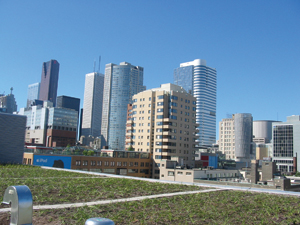 Placing drought-resistant plants atop roofs, as seen here in Toronto, Ontario,
is one way to combat the urban heat island effect. Photo courtesy of Stuart Gaffin.
Placing drought-resistant plants atop roofs, as seen here in Toronto, Ontario,
is one way to combat the urban heat island effect. Photo courtesy of Stuart Gaffin.
Anyone who has been to the heart of a city during the summer is familiar with the urban heat island effect. Air temperatures in cities can be up to 5.6 degrees Celsius (10 degrees Fahrenheit) warmer than the surrounding suburbs and rural areas. New research on ways to mitigate the heat island effect, however, is showing that simple techniques show promise in at least partially reversing the urban warming.
 Placing drought-resistant plants atop roofs, as seen here in Toronto, Ontario,
is one way to combat the urban heat island effect. Photo courtesy of Stuart Gaffin.
Placing drought-resistant plants atop roofs, as seen here in Toronto, Ontario,
is one way to combat the urban heat island effect. Photo courtesy of Stuart Gaffin.
Urban heat islands form as cities replace natural land cover such as grass and trees with pavement, buildings and other infrastructure. Removing trees and vegetation minimizes the natural cooling from shade trees, as well as the cooling effects of the evaporation of water from soil and leaves (evapotranspiration), says Stuart Gaffin, an associate research scientist at Columbia University in New York. Furthermore, dark-colored pavement and rooftops heat up to extreme temperatures in the summertime and "act like open ovens," he says. So-called waste heat from air conditioning and vehicles increase temperatures as well, while cities' tall buildings block solar energy from escaping back into space.
"The effect has been observed for more than a century," Gaffin says. People can feel it, he says, and satellites observe citywide and more localized "hotspots."
In New York City, for example, where the five boroughs average 4 degrees Celsius (7.2 degrees Fahrenheit) warmer than surrounding areas in the summer, certain neighborhoods are even hotter, such as the South Bronx and parts of Brooklyn and Queens, reported Cynthia Rosenzweig of NASA's Goddard Institute for Space Studies and colleagues, including Gaffin, at the annual meeting of the American Meteorological Society in Atlanta in January. But models suggest that ways exist to lessen the impacts of the heat island, so the researchers decided to test a few strategies to see which worked best to lower temperatures in six specific locales and across the entire city.
In New York, during three heat waves in the summer of 2002, Rosenzweig's team tested the effects of "green roofs," "cool roofs" and trees planted at street-level. Cool roofs are as bright or as white as possible to reflect the heat, while green roofs typically have vegetation consisting of small shrubs or drought-resistant plants like sedums to increase evapotranspiration.
In general, the researchers found that such strategies substantially reduced temperatures - up to 1 to 2 degrees Fahrenheit - but some methods had "greater potential to be more effective" than others, depending on the neighborhood. For example, curbside vegetation seemed to cool the local air most effectively overall, and green roofs were more effective at lowering temperature than cool roofs.
In New York City as a whole, however, where some 64 percent of the city's rooftops could be converted to reflective surfaces, cool roofs could cause the "greatest absolute temperature reductions," they reported. "Different neighborhoods will have to weigh the costs and benefits of each technology" before implementing a plan, Gaffin says.
If they are not already, cities of all sizes should begin thinking about urban heat island mitigation plans, as the effect is costly, says Hashem Akbari, scientific leader of the Heat Island Group at Lawrence Berkeley National Laboratory in California. In Los Angeles, for example, the urban heat island effect is directly costing inhabitants more than $100 million per year in increased cooling costs, as the demand for electric power rises 2 percent for every degree Fahrenheit that the daily maximum temperature rises, according to research by the Heat Island Group.
Akbari's group has studied how implementation of mitigation strategies - especially cool roofs - would work in a number of large metropolitan areas. Installing cool roofs in Phoenix, for example, could save the city more than $37 million a year in direct energy savings. Chicago could save $10 million, and Washington, D.C., could save $8 million. Total savings could be much higher, Akbari says, as cities continue to grow, and as temperatures and electricity prices rise.
"It's a vicious cycle - it gets hot, so we burn more energy, causing smog, causing more heat, so we turn on more air conditioning and burn more energy," says Steven Peck, president of Green Roofs for Healthy Cities, a nonprofit group based in Toronto, Ontario. Ameliorating urban heat island effects is quite important not only environmentally but also economically, he says: "No one will want to live in or visit these cities if they're too hot."
Megan Sever
 |
Geotimes Home | AGI Home | Information Services | Geoscience Education | Public Policy | Programs | Publications | Careers |